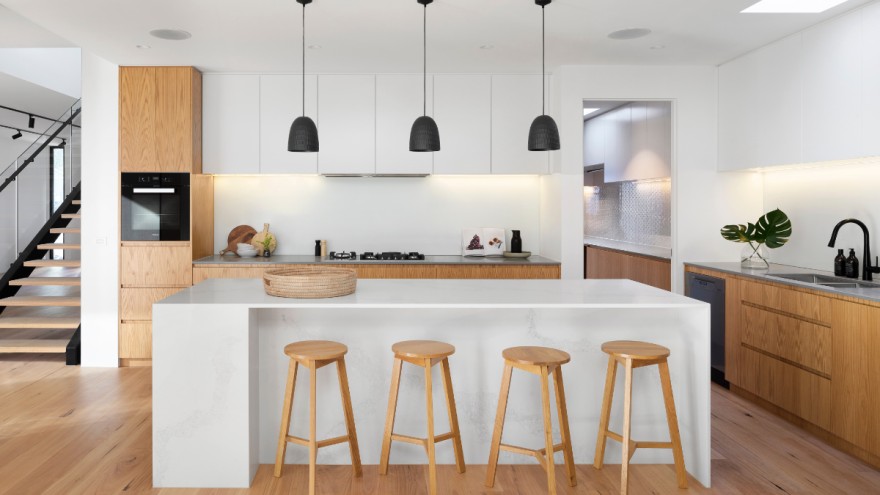Kitchen lighting tips and trends
In addition to kitchen design, storage space and ergonomics, lighting is an important consideration when planning a kitchen. The solution must be in keeping with the style of the kitchen, provide enough light for the work zones and also lend a homely touch. When it comes to chopping and cooking, direct, bright light is fundamental, whereas indirect light sources are needed to create a cosy atmosphere for dining. Read on to discover what matters when choosing a kitchen lighting concept and which kitchen and lamp trends are available on the market right now.

Kitchen lighting has a major impact on the atmosphere of the overall kitchen design. (Photo: R Architecture auf Unsplash)
One concept, three light sources
Kitchens aren’t just for cooking in. Increasingly, they have a central role to play in our lives, as demonstrated by open-plan kitchens and other kitchen trends . A coherent lighting concept based on ambient, task and accent lighting is therefore important.
Ambient or general lighting refers to the uniform distribution of light in a room, provided, for example, by warm white spotlights in the ceiling or uplighters. Task lighting solutions include kitchen worktop lighting. Cool white, shadow-free light sources above the stove, sink or dining table help to bring work surfaces and dining areas into focus. Pendant lamps such as Alexander or SpaceB from Nordlux provide plenty of light, whether for chopping, feasting or washing up.
Last but not least, accent lighting provides the atmosphere. Indirect light in the form of self-adhesive LED strips under wall units, or adjustable wall lights like CYLS from Estiluz create individual highlights and a cosy ambience. Combining different colours and sources of light can result in a balanced lighting concept for the kitchen that is both comfortable and functional.

Lampshades made of natural materials, for example wood like the hanging lamp Ola! by Mundus Viridis d.o.o., provide beautiful accents and natural light. (Photo: Mundus Viridis d.o.o.)
Kitchen trends and the right lighting
Current kitchen design trends can be summed up in two words: homeliness and naturalness. Dark colours like black, grey or dark green are popular because they give the room a pleasant depth. Handleless cabinet fronts in a satin finish look naturally elegant and understated. The focus is on uniquely grained marble or wooden worktops designed to look like thin panels. Floating shelves provide a certain airiness and a hint of minimalism. In addition to plants, natural materials – such as solid wood, bamboo, natural stone and marble – and warm brass and gold tones for fittings help transform a kitchen into a place of well-being.
And so, kitchen lighting is also influenced by nature, with bright, woven pendant lamps made of rattan and l lampshades made of rice paper providing natural light and an exotic charm. Lamps made of wood, such as pendant lamp Ola! or ceiling lamp kuulto-9100 , also add attractive highlights. But powerful colours like yellow, orange or berry red can also be found among the lamp trends. With colourful yarn and wooden rings, the Macaron lamp from EMKO combines naturalness with cheerful colours that energise the kitchen design.

The colorful pendants Macaron lamps from EMKO combine naturalness with cheerful colors. (Photo: EMKO)
The latest trends in interiors and lighting
Whether through lighting or furnishings, the kitchen design of tomorrow blends functionality and cosiness in an aesthetically pleasing overall concept. In terms of kitchen lighting, directly illuminated worktops are combined with indirect light sources. Even more cosiness is created by the lamp trend favouring natural materials and colours – in keeping with the kitchen trend towards maximum homeliness.




